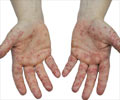Syphilis is one of the oldest diseases that has affected everyone from Henry VIII to Christoper Columbus.
Syphilis is one of the oldest diseases that has affected everyone from Henry VIII to Christoper Columbus. The disease is characterized by a painless sore (ulcer) near the site of infection. The primary sore first appears 3-4 weeks after infection and takes about 6 weeks to clear.
This is followed by generalized skin rash, swollen glands, headache and a sore throat. After a few months or years later tertiary syphilis develops which destroys part of the nervous system, including the brain or the cardiovascular system, especially the aorta. The disease has been documented in diseased bones found in Europe and North Africa. It has been in existence in Europe for the past 2,000 years.The disease has always been associated with travel. The rates of syphilis increased during war, when a large number of lusty but bored men were separated from their women and scattered around the world. After the discovery of penicillin the disease rates began to plummet. Now there are a few occasional cases among students. According to a report from the Health Protection Agency there has been a sudden increase in the number of syphilis cases between 2004 and 2005. Statistics reveal that they recorded 2,390 cases among men which is a 20% increase from 2004. Out of the 2390 cases 1,445 cases were recorded among homosexuals. The increase in the incidence of homosexual syphilis was up 35 % from 2004. 417 cases were recorded among women which is a 47% increase from 2004.









